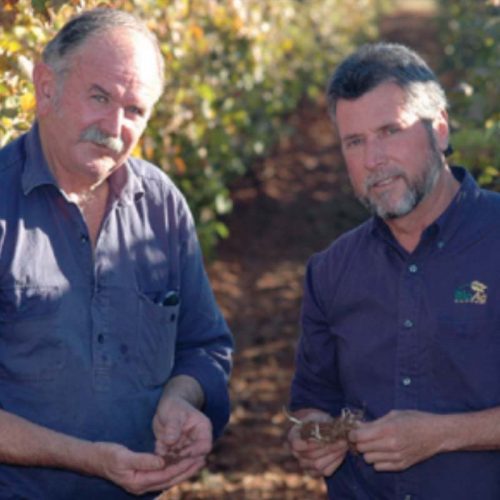
Case
Study
Location
Red Cliffs, Victoria, Australia
Crop
Wine grapes
Wrate Family, Red Cliffs, Victoria.
The adoption of a biological nutrition program and an advanced irrigation scheduling system has paid major dividends for Sunraysia grape growers, John and Alison Wrate.
“I was already growing good quality fruit and yield, but I have always been interested in learning new things. I listened to what Marco had to say and picked up the benefits as we went along.”
A typical BioAg Fertility Program for viticulture involves the application of 350-450kg/ha* BioAgPhos, 100-160kg/ha* sulphate of ammonia in spring. In addition, 1-1.5L/ha* of BioAg Soil & Seed (a liquid treatment that encourages root development and soil microbial activity) and 15-20kg/ha* of calcium nitrate (a rich source of calcium and nitrogen) is applied at 21-day intervals throughout the growing season via the sprinkler system.
During bud burst and flowering, 1.5-2.5 L/ha* of BioAg Balance & Grow, a liquid microbial culture which stimulates vegetative growth and improves soil microbial activity, mixed with small amounts of calcium nitrate and micronutrients as needed, is applied as a foliar spray using an air blaster at 21-day intervals.
This is followed by 1.5-3L/ha* of BioAg Fruit & Balance, a foliar treatment which delivers a rich source of nutrients to enhance yield and quality, and mono ammonium phosphate (MAP) from late flowering to maturation.
“I firmly believe in the concept that healthy soils produce healthy plants – you can’t have one without the other,” John said.

“You have to be prepared to implement the entire program to achieve the results and there is no doubt in my mind that it provides a better outcome than conventional fertiliser programs.
I particularly like the way the BioAg program applies smaller amounts of nutrients throughout the season, rather than just a big chunk in spring and after harvest and then expecting that to last the whole season.
The foliar treatments require a bit more work to apply but they add to the outcome. Overall, we are very happy with the way things are going. We know our soils are in extremely good condition and our vines look healthy all the time – and it shows in our yields and quality.
Things just seem to be ‘clicking’ for us. I am very lucky to have a contract with Orlando Wyndham. Two out of our last three Chardonnay crops were classified Semi- Premium 3, which goes into the Wyndham Estate Bin 222.”
“You have to be prepared to implement the entire program to achieve the results and there is no doubt in my mind that it provides a better outcome than conventional fertiliser program.”
The irrigation schedule, which delivers 11ML per ha per season via overhead sprinklers, is supervised by Mildura-based consultancy, Yandilla Park, using the Enviro Scan system.
“I am now using more water than most growers, but in doing so, I have significantly improved the productivity and profitability of the property,” John said. “Even though I use a lot of water, the drains never run, so the soils are holding onto it and the plants are making better use of it.”
Download case study
Download a PDF version of the above case study.

Recent Comments